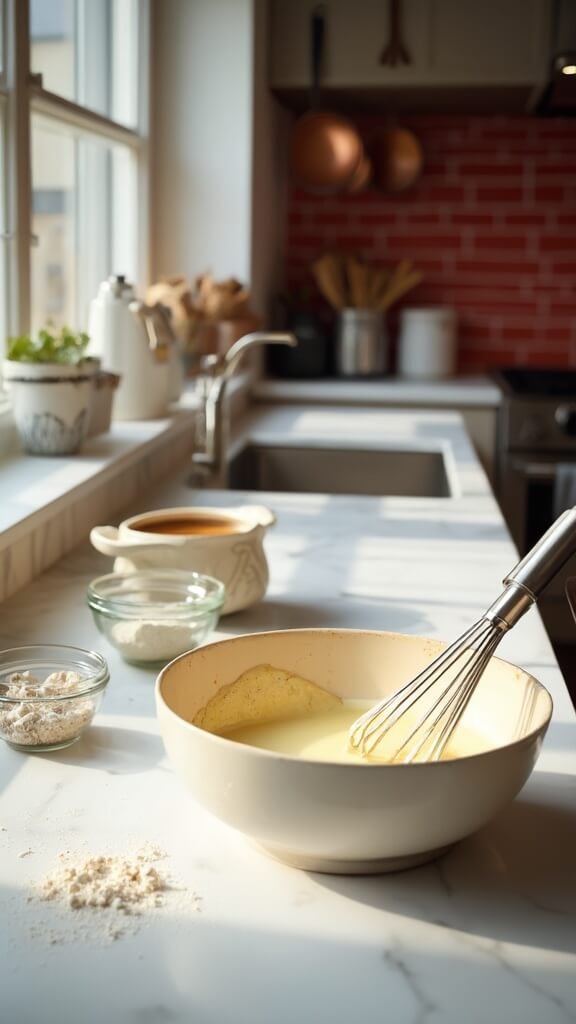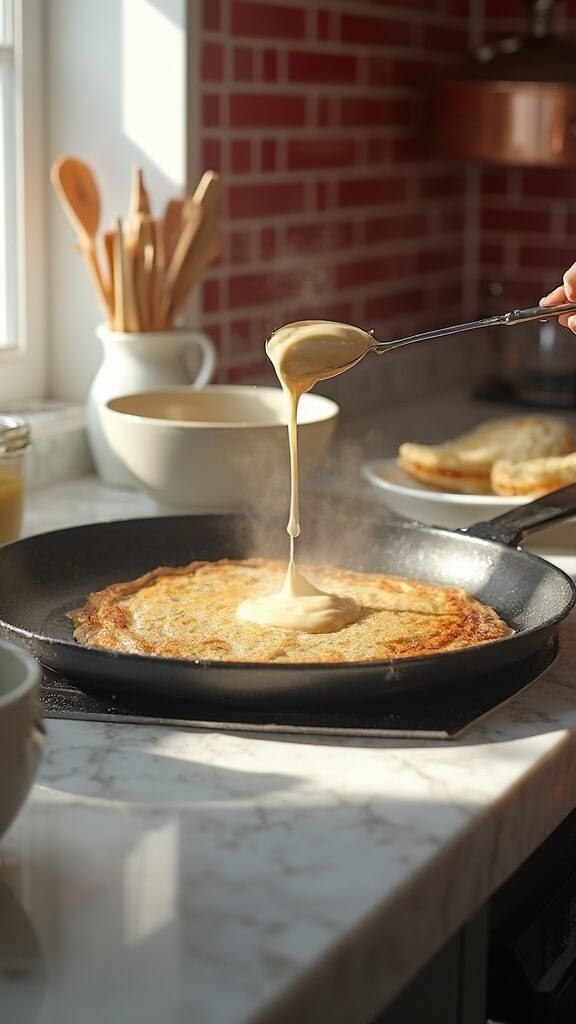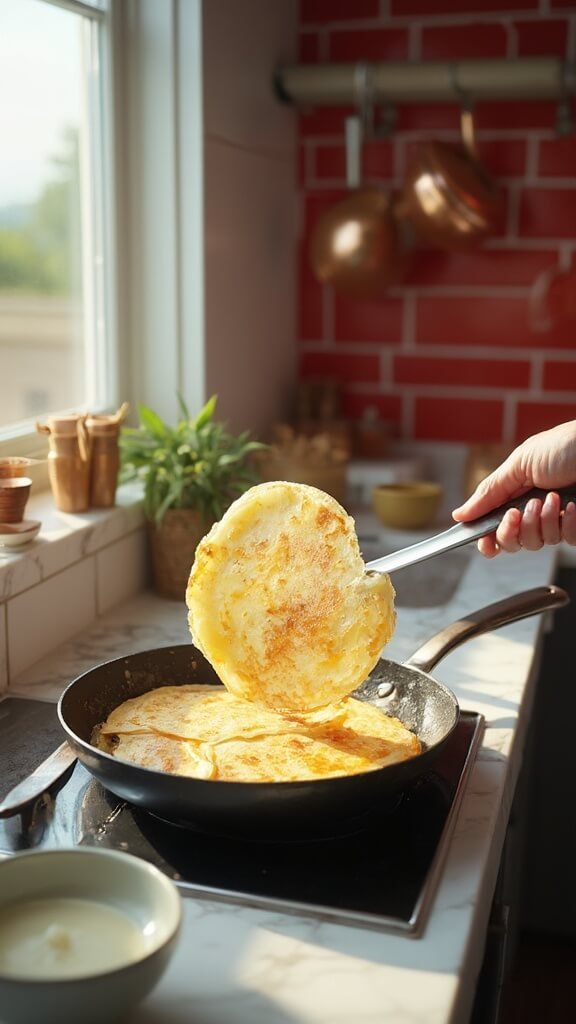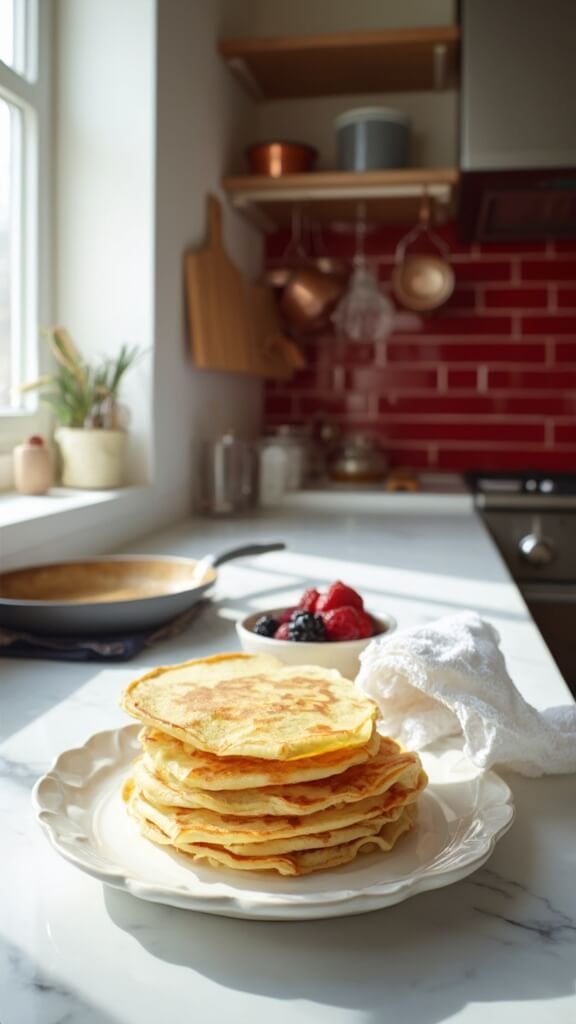French Coconut Flour Crepes: Delicate Gluten-Free Perfection
Have you ever craved those impossibly thin, buttery French crepes but needed to avoid gluten?
Or maybe you’re following a low-carb lifestyle and thought crepes were off the table forever?
I’m about to change your breakfast game completely.
French coconut flour crepes deliver that same silky, delicate texture you remember – without a single grain in sight. These beauties are naturally gluten-free, surprisingly protein-rich, and flexible enough to wrap around any filling your heart desires.

KEY INFO
- Prep time: 15 minutes
- Cook time: 20 minutes
- Total time: 35 minutes
- Servings: 8-10 crepes
- Difficulty level: Moderate
- Dietary tags: Gluten-free, grain-free, keto-friendly, paleo, vegetarian
EQUIPMENT NEEDED
- Medium mixing bowl
- Whisk (or hand mixer)
- 8-inch non-stick skillet or crepe pan
- Thin, wide spatula
- Measuring cups and spoons
- Simple alternatives: Well-seasoned cast iron pan, cake palette knife for flipping
INGREDIENTS
Main batter:
- 4 large eggs
- 1/2 cup (120ml) milk of choice (almond, coconut, or dairy)
- 3 tablespoons (21g) coconut flour
- 1 tablespoon melted coconut oil (or avocado oil)
- 1 tablespoon tapioca starch (omit for strict keto)
Seasonings:
- 1/2 teaspoon vanilla extract (omit for savory crepes)
- 1/4 teaspoon fine sea salt
For cooking:
- Extra oil for pan

Why Coconut Flour Changes Everything
Let me tell you something about coconut flour – it’s nothing like regular flour. This stuff drinks liquid like a sponge and creates the most incredibly tender texture when you treat it right.
I learned this the hard way during my first attempt. I dumped in coconut flour like it was wheat flour and ended up with what looked like scrambled egg pancakes. Complete disaster.
The secret? Less flour, more patience, and always let it rest.
METHOD
- Crack eggs into mixing bowl and whisk until completely smooth.
- Pour in milk and melted oil, whisking until well combined.
- Add coconut flour, tapioca starch, vanilla, and salt. Whisk vigorously until no lumps remain.
- Let batter rest for 10 minutes. This step is crucial – coconut flour needs time to absorb the liquid properly.
- Heat your non-stick skillet over medium-low heat. Brush lightly with oil.
- Pour 2-3 tablespoons of batter into center of pan. Immediately swirl to spread thin.
- Cook for 2-3 minutes until edges lift and bottom is golden brown.
- Flip carefully using your thinnest spatula. Cook second side for 30-60 seconds only.
- Slide onto plate and repeat with remaining batter, re-oiling pan between crepes.

The Art of the Perfect Flip
Here’s where most people panic. Coconut flour crepes are more delicate than traditional ones, but they’re not impossible to flip.
My foolproof flipping technique:
- Wait until you see the edges pulling away from the pan
- Slide your spatula completely under one side
- Lift gently and flip in one confident motion
- Don’t overthink it – hesitation leads to tears
The first crepe is always your sacrifice to the crepe gods anyway. Consider it pan seasoning.

CRUCIAL TIPS
- Start with medium-low heat – coconut flour burns faster than wheat flour
- Don’t skip the resting time – rushing leads to lumpy, thick crepes
- Adjust consistency gradually – add milk 1 tablespoon at a time if batter seems thick
- Keep cooked crepes warm under a clean kitchen towel
- Oil sparingly – too much oil creates greasy, heavy crepes

Sweet vs Savory: Your Crepe Adventure Begins
For sweet crepes, try:
- Fresh berries with whipped coconut cream
- Sliced bananas with almond butter
- Sugar-free chocolate spread with strawberries
- Lemon juice with a dusting of powdered erythritol
For savory masterpieces:
- Smoked salmon with cream cheese and dill
- Sautéed mushrooms with gruyere
- Spinach, feta, and sun-dried tomatoes
- Ham and cheese with a fried egg on top
Storage and Make-Ahead Magic
Storing your crepes:
- Stack cooled crepes with parchment paper between layers
- Refrigerate in airtight container for up to 3 days
- Freeze for up to 1 month
Reheating:
- Gentle warmth in a dry non-stick pan
- 20 seconds in microwave with damp paper towel
- Never use high heat – they’ll turn into coconut chips
Scaling and Variations
Double the recipe easily – just don’t double the coconut flour exactly. Use 5 tablespoons instead of 6 when doubling. Coconut flour doesn’t scale linearly like other flours.
Common mistakes I see:
- Using too much coconut flour (creates thick, dense crepes)
- Cooking over high heat (burns before setting)
- Not letting batter rest (lumpy, uneven texture)
- Flipping too early (crepe falls apart)
Troubleshooting Your Crepe Game
- Batter too thick? Add milk one tablespoon at a time.
- Crepes tearing? Lower your heat and make sure they’re fully set before flipping.
- Not golden enough? Increase heat slightly and ensure your pan is properly preheated.
- Too eggy? Add an extra tablespoon of coconut flour next time.
The beauty of these coconut flour crepes lies in their versatility. Whether you’re hosting an elegant brunch, meal-prepping breakfast for the week, or just treating yourself to something special on a Sunday morning, these deliver every single time.
Once you master the technique, you’ll wonder why you ever thought gluten-free meant giving up the foods you love. These aren’t a compromise – they’re an upgrade.
Now grab your whisk and show that coconut flour who’s boss. Your taste buds will thank you.









